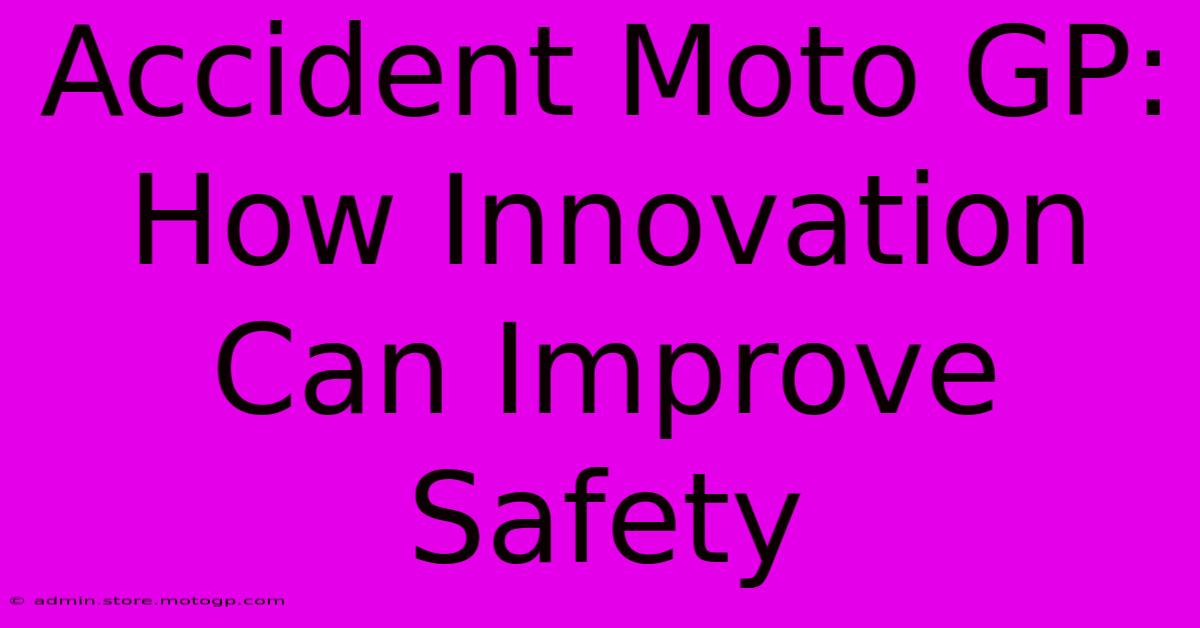Accident Moto GP: How Innovation Can Improve Safety

Table of Contents
Accident Moto GP: How Innovation Can Improve Safety
Motorcycle racing, especially at the elite level of MotoGP, is a thrilling spectacle of speed, skill, and breathtaking maneuvers. However, the inherent risks are undeniable. High-speed crashes are an unfortunate reality, leading to serious injuries and, tragically, sometimes fatalities. While rider skill and track conditions play a significant role, technological innovation holds the key to significantly improving safety in MotoGP. This article explores several areas where advancements can drastically reduce the impact of accidents.
The Current State of Safety in MotoGP
MotoGP boasts impressive safety features already. Advanced protective gear, including sophisticated leathers, helmets, and airbag systems, has minimized the severity of injuries in many crashes. Trackside medical teams are highly trained and equipped to provide immediate, life-saving care. Furthermore, circuit design is constantly evolving, with improvements focused on run-off areas and safer barrier systems.
However, despite these advances, accidents remain a concern. The high speeds involved mean even minor collisions can have catastrophic consequences. This highlights the need for ongoing innovation to push safety boundaries further.
Areas for Technological Advancement
Several key areas offer exciting avenues for improved safety in MotoGP:
-
Improved Protective Gear: While current gear is highly protective, ongoing research into materials science can lead to even more impact-resistant leathers and helmets. Further advancements in airbag technology, including faster deployment times and more comprehensive coverage, are also crucial. Consideration of materials that offer better protection against rotational forces could be groundbreaking.
-
Motorcycle Safety Systems: Electronic rider aids such as traction control and anti-lock brakes are already standard. Future advancements could include automated systems that detect impending crashes and actively intervene, for example, by automatically deploying airbags or reducing engine power. Sophisticated sensors could even predict potential hazards based on rider inputs and track conditions.
-
Trackside Safety Enhancements: Beyond improved barrier systems, the integration of advanced sensor networks across the track could provide real-time data on rider positions, speeds, and potential collision points. This data could alert marshals to impending danger, allowing for quicker response times and potentially preventing accidents entirely. The use of drone technology for rapid medical response could also be explored.
-
Data Analysis and Predictive Modeling: Analyzing data from past accidents, using machine learning and AI, can identify recurring patterns and potential risk factors. This data can then inform track design, safety protocols, and even the development of improved protective equipment. Predictive modeling could help anticipate potentially hazardous situations and implement preventative measures.
The Role of Collaboration
Improving safety in MotoGP requires a collaborative effort. Manufacturers, governing bodies (FIM), race teams, medical professionals, and even data scientists all have crucial roles to play. Open sharing of data and research findings is vital for accelerating progress and ensuring that advancements are implemented quickly and effectively.
Conclusion: A Safer Future for MotoGP
While accidents are an inherent risk in MotoGP, technological innovation offers a path towards a significantly safer future for riders. By investing in research and development, embracing collaboration, and continually pushing the boundaries of safety technology, we can work towards minimizing the risk of serious injuries and fatalities. The pursuit of greater safety not only protects the riders but also enhances the overall spectacle of this thrilling sport. The future of MotoGP is one where the exhilarating speed and skill are matched by an unwavering commitment to the safety of its participants.

Thank you for visiting our website wich cover about Accident Moto GP: How Innovation Can Improve Safety. We hope the information provided has been useful to you. Feel free to contact us if you have any questions or need further assistance. See you next time and dont miss to bookmark.
Featured Posts
-
The Evolution Of Moto Gp Aerodynamic Testing
Feb 18, 2025
-
Club Si Austin F1 Where The Party Never Stops
Feb 18, 2025
-
Us Gp Concerts Sing Along To Your Favorite Songs
Feb 18, 2025
-
Moto Gps Elite The Quest For Most Wins
Feb 18, 2025
-
The Best Motorcyclist A True Pioneer Of The Sport
Feb 18, 2025
